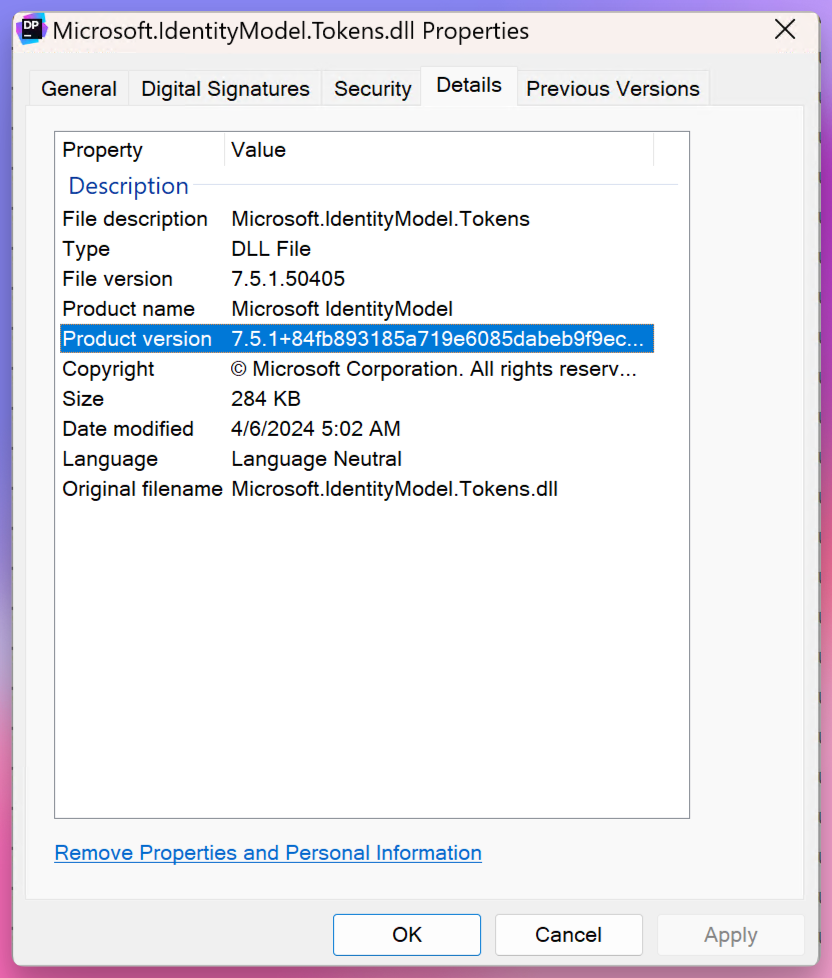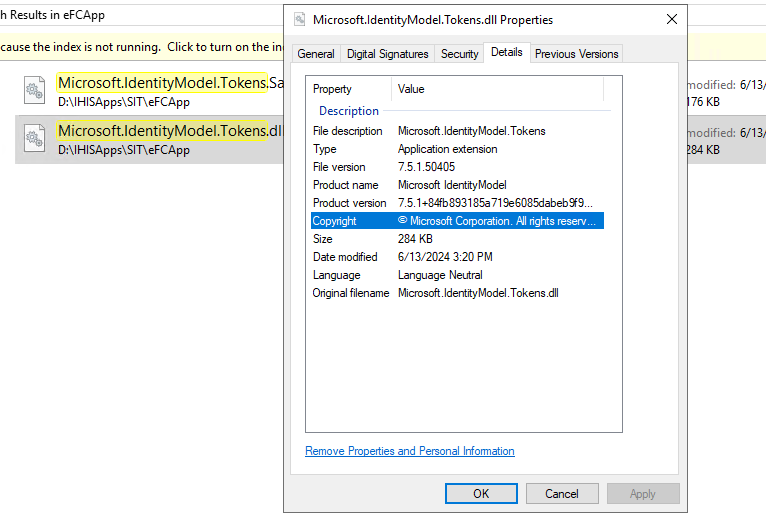Activities of "Priyanka"
well, that's strange.
Can you reproduce this locally by changing environment to production ?
It is working in local environment even if I change environment as production.
csproj
<Project Sdk="Microsoft.NET.Sdk.Web">
<Import Project="..\..\common.props" />
<PropertyGroup>
<TargetFramework>net8.0</TargetFramework>
<AspNetCoreHostingModel>InProcess</AspNetCoreHostingModel>
<RootNamespace>eFC.Web</RootNamespace>
<AssetTargetFallback>$(AssetTargetFallback);portable-net45+win8+wp8+wpa81;</AssetTargetFallback>
<AutoGenerateBindingRedirects>true</AutoGenerateBindingRedirects>
<GenerateBindingRedirectsOutputType>true</GenerateBindingRedirectsOutputType>
<GenerateRuntimeConfigurationFiles>true</GenerateRuntimeConfigurationFiles>
<PreserveCompilationContext>true</PreserveCompilationContext>
<MvcRazorExcludeRefAssembliesFromPublish>false</MvcRazorExcludeRefAssembliesFromPublish>
<PreserveCompilationReferences>true</PreserveCompilationReferences>
<UserSecretsId>48d09d73-95fd-4623-9199-be2c7853284a</UserSecretsId>
<DockerDefaultTargetOS>Linux</DockerDefaultTargetOS>
<DockerfileContext>..\..</DockerfileContext>
<OutputType>Exe</OutputType>
</PropertyGroup>
<PropertyGroup Condition=" '$(Configuration)|$(Platform)' == 'Debug|AnyCPU' ">
<LangVersion>9.0</LangVersion>
</PropertyGroup>
<PropertyGroup Condition=" '$(Configuration)|$(Platform)' == 'Release|AnyCPU' ">
<LangVersion>9.0</LangVersion>
</PropertyGroup>
<ItemGroup>
<Compile Remove="Logs\**" />
<Content Remove="Logs\**" />
<EmbeddedResource Remove="Logs\**" />
<None Remove="Logs\**" />
<None Remove="Controller\" />
<None Remove="Pages\Account\" />
<None Remove="Pages\ADFS\" />
<None Remove="System.DirectoryServices" />
<None Remove="System.DirectoryServices.AccountManagement" />
<None Remove="Microsoft.AspNetCore.DataProtection.EntityFrameworkCore" />
<None Remove="TextTemplate\ETBSBodyTemplate.tpl" />
<None Remove="TextTemplate\ETBSColumnTemplate.tpl" />
<None Remove="TextTemplate\ETBSHeaderTemplate.tpl" />
<None Remove="TextTemplate\ETBSPreviewBodyTemplate.tpl" />
<None Remove="TextTemplate\ETBSTotalEstimationTemplate.tpl" />
<None Remove="TextTemplate\FCTypeContactNoEmail.tpl" />
<None Remove="TextTemplate\FooterTemplate.tpl" />
<None Remove="TextTemplate\UserTeamEmail.tpl" />
<None Remove="TextTemplate\VisitCancellationEmail.tpl" />
</ItemGroup>
<ItemGroup>
<Content Include="Pages\**\*.js">
<CopyToOutputDirectory>Always</CopyToOutputDirectory>
</Content>
<Content Include="Pages\**\*.css">
<CopyToOutputDirectory>Always</CopyToOutputDirectory>
</Content>
</ItemGroup>
<ItemGroup>
<Compile Remove="eFCAbpClaimsPrincipalContributor.cs" />
<Compile Remove="eFCAbpClaimsService.cs" />
<Compile Remove="Pages\UploadedFiles\EditModal.cshtml.cs" />
</ItemGroup>
<ItemGroup>
<Content Remove="Pages\UploadedFiles\EditModal.cshtml" />
</ItemGroup>
<ItemGroup>
<EmbeddedResource Include="TextTemplate\FooterTemplate.tpl" />
<EmbeddedResource Include="TextTemplate\ETBSBodyTemplate.tpl" />
<EmbeddedResource Include="TextTemplate\ETBSColumnTemplate.tpl" />
<EmbeddedResource Include="TextTemplate\ETBSHeaderTemplate.tpl" />
<EmbeddedResource Include="TextTemplate\ETBSPreviewBodyTemplate.tpl" />
<EmbeddedResource Include="TextTemplate\ETBSTotalEstimationTemplate.tpl" />
<EmbeddedResource Include="TextTemplate\FCTypeContactNoEmail.tpl" />
<EmbeddedResource Include="TextTemplate\UserTeamEmail.tpl" />
<EmbeddedResource Include="TextTemplate\VisitCancellationEmail.tpl" />
</ItemGroup>
<ItemGroup>
<None Include="Pages\UploadedFiles\CreateModal.cshtml" />
<None Include="Pages\UploadedFiles\Index.cshtml" />
<None Include="wwwroot\images\logo\logo-dark.png" />
<None Include="wwwroot\images\logo\logo-light.png" />
</ItemGroup>
<ItemGroup>
<PackageReference Include="AspNetCore.HealthChecks.UI" Version="8.0.1" />
<PackageReference Include="AspNetCore.HealthChecks.UI.Client" Version="8.0.1" />
<PackageReference Include="AspNetCore.HealthChecks.UI.InMemory.Storage" Version="8.0.1" />
<PackageReference Include="Microsoft.EntityFrameworkCore.InMemory" Version="8.0.6" />
<PackageReference Include="Microsoft.Extensions.Hosting.WindowsServices" Version="8.0.0" />
<PackageReference Include="Microsoft.IdentityModel.JsonWebTokens" Version="7.5.1" />
<PackageReference Include="Microsoft.IdentityModel.Protocols.OpenIdConnect" Version="7.5.1" />
<PackageReference Include="Microsoft.IdentityModel.Tokens" Version="7.5.1" />
<PackageReference Include="Microsoft.VisualStudio.Azure.Containers.Tools.Targets" Version="1.20.1" />
<PackageReference Include="Serilog.AspNetCore" Version="8.0.1" />
<PackageReference Include="Serilog.Sinks.Async" Version="2.0.0" />
<PackageReference Include="Microsoft.AspNetCore.Authentication.Google" Version="8.0.6" />
<PackageReference Include="Microsoft.AspNetCore.Authentication.MicrosoftAccount" Version="8.0.6" />
<PackageReference Include="Microsoft.AspNetCore.Authentication.Twitter" Version="8.0.6" />
<PackageReference Include="System.DirectoryServices.AccountManagement" Version="8.0.0" />
<PackageReference Include="Microsoft.AspNetCore.DataProtection.EntityFrameworkCore" Version="8.0.6" />
<PackageReference Include="Volo.Abp.Account.Pro.Public.Web.OpenIddict" Version="8.1.3" />
<PackageReference Include="Volo.Abp.OpenIddict.Pro.Web" Version="8.1.3" />
</ItemGroup>
<ItemGroup>
<ProjectReference Include="..\eFC.Application\eFC.Application.csproj" />
<ProjectReference Include="..\eFC.HttpApi\eFC.HttpApi.csproj" />
<ProjectReference Include="..\eFC.EntityFrameworkCore\eFC.EntityFrameworkCore.csproj" />
<PackageReference Include="Volo.Abp.Autofac" Version="8.1.3" />
<PackageReference Include="Volo.Abp.AspNetCore.Serilog" Version="8.1.3" />
<PackageReference Include="Volo.Abp.AspNetCore.Authentication.JwtBearer" Version="8.1.3" />
<PackageReference Include="Volo.Abp.Swashbuckle" Version="8.1.3" />
<PackageReference Include="Volo.Abp.FeatureManagement.Web" Version="8.1.3" />
<PackageReference Include="Volo.Abp.Account.Pro.Admin.Web" Version="8.1.3" />
<PackageReference Include="Volo.Abp.AuditLogging.Web" Version="8.1.3" />
<PackageReference Include="Volo.Abp.Identity.Pro.Web" Version="8.1.3" />
<PackageReference Include="Volo.Abp.LeptonTheme.Management.Web" Version="8.1.3" />
<PackageReference Include="Volo.Abp.LanguageManagement.Web" Version="8.1.3" />
<PackageReference Include="Volo.Saas.Host.Web" Version="8.1.3" />
<PackageReference Include="Volo.Abp.AspNetCore.Mvc.UI.Theme.Lepton" Version="8.1.3" />
<PackageReference Include="Volo.Abp.TextTemplateManagement.Web" Version="8.1.3" />
</ItemGroup>
<ItemGroup>
<Folder Include="bin\Debug\net8.0\" />
<Folder Include="Pages\Account\" />
</ItemGroup>
</Project>
hi
Please add the below packages to your
eFCApp'scsprojfile.<PackageReference Include="Microsoft.IdentityModel.Protocols.OpenIdConnect" Version="7.5.1" /> <PackageReference Include="Microsoft.IdentityModel.Tokens" Version="7.5.1" /> <PackageReference Include="Microsoft.IdentityModel.JsonWebTokens" Version="7.5.1" />
Hi, as suggested, I have added these packages and deployed the code, still getting the same error
2024-06-13 15:48:42.558 +08:00 [INF] Initialized all ABP modules.
2024-06-13 15:48:42.669 +08:00 [INF] Request starting HTTP/1.1 GET https://efcapp.devhealthgrp.com.sg/SIT/eFCApp/api/app/e-fCPermission/e-fCPermissions-by-institution-id - null null
2024-06-13 15:48:42.669 +08:00 [INF] Request starting HTTP/1.1 GET https://efcapp.devhealthgrp.com.sg/SIT/eFCApp/connect/authorize?client_id=eFC_App&redirect_uri=https%3A%2f%2fefc.devhealthgrp.com.sg%2fSIT%2feFCApp&response_type=code&scope=openid%20offline_access&state=d7684820244346f69e23e3a4e431f7ba&code_challenge=QGiJ8SlDDYZGFXs0JS6RbHpW7J_cK_Gyaua0riTqyEI&code_challenge_method=S256&response_mode=query - null null
2024-06-13 15:48:42.669 +08:00 [INF] Request starting HTTP/1.1 GET https://efcapp.devhealthgrp.com.sg/SIT/eFCApp/api/app/code-look-ups?CodeSystem=EFCIdleTimeout&SkipCount=0&MaxResultCount=1000 - null null
2024-06-13 15:48:43.377 +08:00 [INF] Application started. Press Ctrl+C to shut down.
2024-06-13 15:48:43.377 +08:00 [INF] Hosting environment: Production
2024-06-13 15:48:43.377 +08:00 [INF] Content root path: D:\IHISApps\SIT\eFCApp
2024-06-13 15:48:44.093 +08:00 [INF] The request URI matched a server endpoint: "Authorization".
2024-06-13 15:48:44.109 +08:00 [INF] The authorization request was successfully extracted: {
"client_id": "eFC_App",
"redirect_uri": "https://efc.devhealthgrp.com.sg/SIT/eFCApp",
"response_type": "code",
"scope": "openid offline_access",
"state": "d7684820244346f69e23e3a4e431f7ba",
"code_challenge": "QGiJ8SlDDYZGFXs0JS6RbHpW7J_cK_Gyaua0riTqyEI",
"code_challenge_method": "S256",
"response_mode": "query"
}.
2024-06-13 15:48:44.166 +08:00 [INF] Failed to validate the token.
Microsoft.IdentityModel.Tokens.SecurityTokenMalformedException: IDX14100: JWT is not well formed, there are no dots (.).
The token needs to be in JWS or JWE Compact Serialization Format. (JWS): 'EncodedHeader.EndcodedPayload.EncodedSignature'. (JWE): 'EncodedProtectedHeader.EncodedEncryptedKey.EncodedInitializationVector.EncodedCiphertext.EncodedAuthenticationTag'.
---> Microsoft.IdentityModel.Tokens.SecurityTokenMalformedException: IDX14100: JWT is not well formed, there are no dots (.).
The token needs to be in JWS or JWE Compact Serialization Format. (JWS): 'EncodedHeader.EndcodedPayload.EncodedSignature'. (JWE): 'EncodedProtectedHeader.EncodedEncryptedKey.EncodedInitializationVector.EncodedCiphertext.EncodedAuthenticationTag'.
at Microsoft.IdentityModel.JsonWebTokens.JsonWebToken.ReadToken(ReadOnlyMemory`1 encodedTokenMemory)
at Microsoft.IdentityModel.JsonWebTokens.JsonWebToken..ctor(String jwtEncodedString)
at Microsoft.IdentityModel.JsonWebTokens.JsonWebTokenHandler.ReadToken(String token, TokenValidationParameters validationParameters)
--- End of inner exception stack trace ---
2024-06-13 15:48:44.166 +08:00 [INF] Failed to validate the token.
Microsoft.IdentityModel.Tokens.SecurityTokenMalformedException: IDX14100: JWT is not well formed, there are no dots (.).
The token needs to be in JWS or JWE Compact Serialization Format. (JWS): 'EncodedHeader.EndcodedPayload.EncodedSignature'. (JWE): 'EncodedProtectedHeader.EncodedEncryptedKey.EncodedInitializationVector.EncodedCiphertext.EncodedAuthenticationTag'.
---> Microsoft.IdentityModel.Tokens.SecurityTokenMalformedException: IDX14100: JWT is not well formed, there are no dots (.).
The token needs to be in JWS or JWE Compact Serialization Format. (JWS): 'EncodedHeader.EndcodedPayload.EncodedSignature'. (JWE): 'EncodedProtectedHeader.EncodedEncryptedKey.EncodedInitializationVector.EncodedCiphertext.EncodedAuthenticationTag'.
at Microsoft.IdentityModel.JsonWebTokens.JsonWebToken.ReadToken(ReadOnlyMemory`1 encodedTokenMemory)
at Microsoft.IdentityModel.JsonWebTokens.JsonWebToken..ctor(String jwtEncodedString)
at Microsoft.IdentityModel.JsonWebTokens.JsonWebTokenHandler.ReadToken(String token, TokenValidationParameters validationParameters)
--- End of inner exception stack trace ---
hi
- Go to IIS Manager
- Go to the application pool instance
- Click advanced settings
- Under Process model, set Load User Profile to true
Hi, finally application is loading with this step but on login getting issue, below is the log
2024-06-13 14:34:44.900 +08:00 [INF] Initialized all ABP modules.
2024-06-13 14:34:45.034 +08:00 [INF] Request starting HTTP/1.1 GET https://efcapp.devhealthgrp.com.sg/SIT/eFCApp/api/app/e-fCPermission/e-fCPermissions-by-institution-id - null null
2024-06-13 14:34:45.034 +08:00 [INF] Request starting HTTP/1.1 GET https://efcapp.devhealthgrp.com.sg/SIT/eFCApp/connect/authorize?client_id=eFC_App&redirect_uri=https%3A%2f%2fefc.devhealthgrp.com.sg%2fSIT%2feFCApp&response_type=code&scope=openid%20offline_access&state=f18bf6490e5a4bef98c15169920b6f41&code_challenge=bLAaGpFnzPnovJ-a-Kg6VvZvVK7gOEAQP0noo5U4CbQ&code_challenge_method=S256&response_mode=query - null null
2024-06-13 14:34:45.034 +08:00 [INF] Request starting HTTP/1.1 GET https://efcapp.devhealthgrp.com.sg/SIT/eFCApp/api/app/code-look-ups?CodeSystem=EFCIdleTimeout&SkipCount=0&MaxResultCount=1000 - null null
2024-06-13 14:34:45.781 +08:00 [INF] Application started. Press Ctrl+C to shut down.
2024-06-13 14:34:45.781 +08:00 [INF] Hosting environment: Production
2024-06-13 14:34:45.781 +08:00 [INF] Content root path: D:\IHISApps\SIT\eFCApp
2024-06-13 14:34:46.570 +08:00 [INF] The request URI matched a server endpoint: "Authorization".
2024-06-13 14:34:46.588 +08:00 [INF] The authorization request was successfully extracted: {
"client_id": "eFC_App",
"redirect_uri": "https://efc.devhealthgrp.com.sg/SIT/eFCApp",
"response_type": "code",
"scope": "openid offline_access",
"state": "f18bf6490e5a4bef98c15169920b6f41",
"code_challenge": "bLAaGpFnzPnovJ-a-Kg6VvZvVK7gOEAQP0noo5U4CbQ",
"code_challenge_method": "S256",
"response_mode": "query"
}.
2024-06-13 14:34:46.650 +08:00 [INF] Failed to validate the token.
Microsoft.IdentityModel.Tokens.SecurityTokenMalformedException: IDX14100: JWT is not well formed, there are no dots (.).
The token needs to be in JWS or JWE Compact Serialization Format. (JWS): 'EncodedHeader.EndcodedPayload.EncodedSignature'. (JWE): 'EncodedProtectedHeader.EncodedEncryptedKey.EncodedInitializationVector.EncodedCiphertext.EncodedAuthenticationTag'.
---> Microsoft.IdentityModel.Tokens.SecurityTokenMalformedException: IDX14100: JWT is not well formed, there are no dots (.).
The token needs to be in JWS or JWE Compact Serialization Format. (JWS): 'EncodedHeader.EndcodedPayload.EncodedSignature'. (JWE): 'EncodedProtectedHeader.EncodedEncryptedKey.EncodedInitializationVector.EncodedCiphertext.EncodedAuthenticationTag'.
at Microsoft.IdentityModel.JsonWebTokens.JsonWebToken.ReadToken(String encodedJson)
at Microsoft.IdentityModel.JsonWebTokens.JsonWebToken..ctor(String jwtEncodedString)
at Microsoft.IdentityModel.JsonWebTokens.JsonWebTokenHandler.ReadToken(String token, TokenValidationParameters validationParameters)
--- End of inner exception stack trace ---
2024-06-13 14:34:46.650 +08:00 [INF] Failed to validate the token.
Microsoft.IdentityModel.Tokens.SecurityTokenMalformedException: IDX14100: JWT is not well formed, there are no dots (.).
The token needs to be in JWS or JWE Compact Serialization Format. (JWS): 'EncodedHeader.EndcodedPayload.EncodedSignature'. (JWE): 'EncodedProtectedHeader.EncodedEncryptedKey.EncodedInitializationVector.EncodedCiphertext.EncodedAuthenticationTag'.
---> Microsoft.IdentityModel.Tokens.SecurityTokenMalformedException: IDX14100: JWT is not well formed, there are no dots (.).
The token needs to be in JWS or JWE Compact Serialization Format. (JWS): 'EncodedHeader.EndcodedPayload.EncodedSignature'. (JWE): 'EncodedProtectedHeader.EncodedEncryptedKey.EncodedInitializationVector.EncodedCiphertext.EncodedAuthenticationTag'.
at Microsoft.IdentityModel.JsonWebTokens.JsonWebToken.ReadToken(String encodedJson)
at Microsoft.IdentityModel.JsonWebTokens.JsonWebToken..ctor(String jwtEncodedString)
at Microsoft.IdentityModel.JsonWebTokens.JsonWebTokenHandler.ReadToken(String token, TokenValidationParameters validationParameters)
--- End of inner exception stack trace ---
2024-06-13 14:34:46.651 +08:00 [INF] Bearer was not authenticated. Failure message: IDX14100: JWT is not well formed, there are no dots (.).
The token needs to be in JWS or JWE Compact Serialization Format. (JWS): 'EncodedHeader.EndcodedPayload.EncodedSignature'. (JWE): 'EncodedProtectedHeader.EncodedEncryptedKey.EncodedInitializationVector.EncodedCiphertext.EncodedAuthenticationTag'.
2024-06-13 14:34:46.651 +08:00 [INF] Bearer was not authenticated. Failure message: IDX14100: JWT is not well formed, there are no dots (.).
The token needs to be in JWS or JWE Compact Serialization Format. (JWS): 'EncodedHeader.EndcodedPayload.EncodedSignature'. (JWE): 'EncodedProtectedHeader.EncodedEncryptedKey.EncodedInitializationVector.EncodedCiphertext.EncodedAuthenticationTag'.
2024-06-13 14:34:46.859 +08:00 [INF] OpenIddict.Validation.AspNetCore was not authenticated. Failure message: An error occurred while authenticating the current request.
2024-06-13 14:34:46.859 +08:00 [INF] OpenIddict.Validation.AspNetCore was not authenticated. Failure message: An error occurred while authenticating the current request.
2024-06-13 14:34:46.904 +08:00 [INF] Authorization failed. These requirements were not met:
DenyAnonymousAuthorizationRequirement: Requires an authenticated user.
2024-06-13 14:34:46.904 +08:00 [INF] Authorization failed. These requirements were not met:
DenyAnonymousAuthorizationRequirement: Requires an authenticated user.
2024-06-13 14:34:46.912 +08:00 [INF] AuthenticationScheme: Identity.Application was challenged.
2024-06-13 14:34:46.912 +08:00 [INF] AuthenticationScheme: Identity.Application was challenged.
2024-06-13 14:34:46.962 +08:00 [INF] Request finished HTTP/1.1 GET https://efcapp.devhealthgrp.com.sg/SIT/eFCApp/api/app/e-fCPermission/e-fCPermissions-by-institution-id - 302 null null 1934.591ms
2024-06-13 14:34:46.962 +08:00 [INF] Request finished HTTP/1.1 GET https://efcapp.devhealthgrp.com.sg/SIT/eFCApp/api/app/code-look-ups?CodeSystem=EFCIdleTimeout&SkipCount=0&MaxResultCount=1000 - 302 null null 1934.5976ms
2024-06-13 14:34:46.976 +08:00 [INF] Request starting HTTP/1.1 GET https://efcapp.devhealthgrp.com.sg/SIT/eFCApp/Account/Login?ReturnUrl=%2fSIT%2feFCApp%2fapi%2fapp%2fcode-look-ups%3FCodeSystem%3DEFCIdleTimeout%26SkipCount%3D0%26MaxResultCount%3D1000 - null null
2024-06-13 14:34:46.991 +08:00 [INF] Failed to validate the token.
Microsoft.IdentityModel.Tokens.SecurityTokenMalformedException: IDX14100: JWT is not well formed, there are no dots (.).
The token needs to be in JWS or JWE Compact Serialization Format. (JWS): 'EncodedHeader.EndcodedPayload.EncodedSignature'. (JWE): 'EncodedProtectedHeader.EncodedEncryptedKey.EncodedInitializationVector.EncodedCiphertext.EncodedAuthenticationTag'.
---> Microsoft.IdentityModel.Tokens.SecurityTokenMalformedException: IDX14100: JWT is not well formed, there are no dots (.).
The token needs to be in JWS or JWE Compact Serialization Format. (JWS): 'EncodedHeader.EndcodedPayload.EncodedSignature'. (JWE): 'EncodedProtectedHeader.EncodedEncryptedKey.EncodedInitializationVector.EncodedCiphertext.EncodedAuthenticationTag'.
at Microsoft.IdentityModel.JsonWebTokens.JsonWebToken.ReadToken(String encodedJson)
at Microsoft.IdentityModel.JsonWebTokens.JsonWebToken..ctor(String jwtEncodedString)
at Microsoft.IdentityModel.JsonWebTokens.JsonWebTokenHandler.ReadToken(String token, TokenValidationParameters validationParameters)
--- End of inner exception stack trace ---
2024-06-13 14:34:46.991 +08:00 [INF] Bearer was not authenticated. Failure message: IDX14100: JWT is not well formed, there are no dots (.).
The token needs to be in JWS or JWE Compact Serialization Format. (JWS): 'EncodedHeader.EndcodedPayload.EncodedSignature'. (JWE): 'EncodedProtectedHeader.EncodedEncryptedKey.EncodedInitializationVector.EncodedCiphertext.EncodedAuthenticationTag'.
2024-06-13 14:34:46.994 +08:00 [INF] OpenIddict.Validation.AspNetCore was not authenticated. Failure message: An error occurred while authenticating the current request.
2024-06-13 14:34:47.022 +08:00 [INF] Request starting HTTP/1.1 GET https://efcapp.devhealthgrp.com.sg/SIT/eFCApp/Account/Login?ReturnUrl=%2fSIT%2feFCApp%2fapi%2fapp%2fe-fCPermission%2fe-fCPermissions-by-institution-id - null null
2024-06-13 14:34:47.032 +08:00 [INF] Failed to validate the token.
Microsoft.IdentityModel.Tokens.SecurityTokenMalformedException: IDX14100: JWT is not well formed, there are no dots (.).
The token needs to be in JWS or JWE Compact Serialization Format. (JWS): 'EncodedHeader.EndcodedPayload.EncodedSignature'. (JWE): 'EncodedProtectedHeader.EncodedEncryptedKey.EncodedInitializationVector.EncodedCiphertext.EncodedAuthenticationTag'.
---> Microsoft.IdentityModel.Tokens.SecurityTokenMalformedException: IDX14100: JWT is not well formed, there are no dots (.).
The token needs to be in JWS or JWE Compact Serialization Format. (JWS): 'EncodedHeader.EndcodedPayload.EncodedSignature'. (JWE): 'EncodedProtectedHeader.EncodedEncryptedKey.EncodedInitializationVector.EncodedCiphertext.EncodedAuthenticationTag'.
at Microsoft.IdentityModel.JsonWebTokens.JsonWebToken.ReadToken(String encodedJson)
at Microsoft.IdentityModel.JsonWebTokens.JsonWebToken..ctor(String jwtEncodedString)
at Microsoft.IdentityModel.JsonWebTokens.JsonWebTokenHandler.ReadToken(String token, TokenValidationParameters validationParameters)
--- End of inner exception stack trace ---
please help if some setting is still missing. thank you.
Yes,
eFC.Web, You also can create a new latest template project and check the code.
Hi, I have added cert and above-mentioned code but still getting the same error
this time log is different
2024-06-13 12:58:37.930 +08:00 [INF] Starting web host.
2024-06-13 12:58:43.172 +08:00 [FTL] Host terminated unexpectedly!
Volo.Abp.AbpInitializationException: An error occurred during ConfigureServices phase of the module Volo.Abp.OpenIddict.AbpOpenIddictAspNetCoreModule, Volo.Abp.OpenIddict.AspNetCore, Version=8.1.3.0, Culture=neutral, PublicKeyToken=null. See the inner exception for details.
---> System.Security.Cryptography.CryptographicException: The system cannot find the file specified.
at System.Security.Cryptography.X509Certificates.CertificatePal.FilterPFXStore(ReadOnlySpan`1 rawData, SafePasswordHandle password, PfxCertStoreFlags pfxCertStoreFlags)
at System.Security.Cryptography.X509Certificates.CertificatePal.FromBlobOrFile(ReadOnlySpan`1 rawData, String fileName, SafePasswordHandle password, X509KeyStorageFlags keyStorageFlags)
at System.Security.Cryptography.X509Certificates.CertificatePal.FromFile(String fileName, SafePasswordHandle password, X509KeyStorageFlags keyStorageFlags)
at System.Security.Cryptography.X509Certificates.X509Certificate..ctor(String fileName, String password, X509KeyStorageFlags keyStorageFlags)
at System.Security.Cryptography.X509Certificates.X509Certificate..ctor(String fileName, String password)
at System.Security.Cryptography.X509Certificates.X509Certificate2..ctor(String fileName, String password)
at Microsoft.Extensions.DependencyInjection.OpenIddictServerBuilderExtensions.AddProductionEncryptionAndSigningCertificate(OpenIddictServerBuilder builder, String fileName, String passPhrase)
at eFC.Web.eFCWebModule.<>c.<PreConfigureServices>b__0_1(OpenIddictServerBuilder serverBuilder) in /agents/work/4/69/s/src/src/eFC.Web/eFCWebModule.cs:line 97
at Volo.Abp.Options.PreConfigureActionList`1.Configure(TOptions options)
at Microsoft.Extensions.DependencyInjection.ServiceCollectionPreConfigureExtensions.ExecutePreConfiguredActions[TOptions](IServiceCollection services, TOptions options)
at Volo.Abp.OpenIddict.AbpOpenIddictAspNetCoreModule.<>c__DisplayClass1_0.<AddOpenIddictServer>b__0(OpenIddictServerBuilder builder)
at Microsoft.Extensions.DependencyInjection.OpenIddictServerExtensions.AddServer(OpenIddictBuilder builder, Action`1 configuration)
at Volo.Abp.OpenIddict.AbpOpenIddictAspNetCoreModule.AddOpenIddictServer(IServiceCollection services)
at Volo.Abp.OpenIddict.AbpOpenIddictAspNetCoreModule.ConfigureServices(ServiceConfigurationContext context)
at Volo.Abp.AbpApplicationBase.ConfigureServices()
--- End of inner exception stack trace ---
at Volo.Abp.AbpApplicationBase.ConfigureServices()
at Volo.Abp.AbpApplicationBase..ctor(Type startupModuleType, IServiceCollection services, Action`1 optionsAction)
at Volo.Abp.AbpApplicationWithExternalServiceProvider..ctor(Type startupModuleType, IServiceCollection services, Action`1 optionsAction)
at Volo.Abp.AbpApplicationFactory.Create(Type startupModuleType, IServiceCollection services, Action`1 optionsAction)
at Volo.Abp.AbpApplicationFactory.Create[TStartupModule](IServiceCollection services, Action`1 optionsAction)
at Microsoft.Extensions.DependencyInjection.ServiceCollectionApplicationExtensions.AddApplication[TStartupModule](IServiceCollection services, Action`1 optionsAction)
at eFC.Web.Startup.ConfigureServices(IServiceCollection services) in /agents/work/4/69/s/src/src/eFC.Web/Startup.cs:line 12
at System.RuntimeMethodHandle.InvokeMethod(Object target, Void** arguments, Signature sig, Boolean isConstructor)
at System.Reflection.MethodBaseInvoker.InterpretedInvoke_Method(Object obj, IntPtr* args)
at System.Reflection.MethodBaseInvoker.InvokeDirectByRefWithFewArgs(Object obj, Span`1 copyOfArgs, BindingFlags invokeAttr)
at System.Reflection.MethodBaseInvoker.InvokeWithOneArg(Object obj, BindingFlags invokeAttr, Binder binder, Object[] parameters, CultureInfo culture)
at System.Reflection.RuntimeMethodInfo.Invoke(Object obj, BindingFlags invokeAttr, Binder binder, Object[] parameters, CultureInfo culture)
at Microsoft.AspNetCore.Hosting.MethodInfoExtensions.InvokeWithoutWrappingExceptions(MethodInfo methodInfo, Object obj, Object[] parameters)
at Microsoft.AspNetCore.Hosting.ConfigureServicesBuilder.InvokeCore(Object instance, IServiceCollection services)
at Microsoft.AspNetCore.Hosting.ConfigureServicesBuilder.<>c__DisplayClass9_0.<Invoke>g__Startup|0(IServiceCollection serviceCollection)
at Microsoft.AspNetCore.Hosting.ConfigureServicesBuilder.Invoke(Object instance, IServiceCollection services)
at Microsoft.AspNetCore.Hosting.ConfigureServicesBuilder.<>c__DisplayClass8_0.<Build>b__0(IServiceCollection services)
at Microsoft.AspNetCore.Hosting.GenericWebHostBuilder.UseStartup(Type startupType, HostBuilderContext context, IServiceCollection services, Object instance)
at Microsoft.AspNetCore.Hosting.GenericWebHostBuilder.<>c__DisplayClass7_0.<UseStartup>b__0(HostBuilderContext context, IServiceCollection services)
at Microsoft.Extensions.Hosting.HostBuilder.InitializeServiceProvider()
at Microsoft.Extensions.Hosting.HostBuilder.Build()
at eFC.Web.Program.Main(String[] args) in /agents/work/4/69/s/src/src/eFC.Web/Program.cs:line 36
Please suggest if anything is missed.
No, only this
pfxfile. and configure it in code.public override void PreConfigureServices(ServiceConfigurationContext context) { var hostingEnvironment = context.Services.GetHostingEnvironment(); if (!hostingEnvironment.IsDevelopment()) { PreConfigure<AbpOpenIddictAspNetCoreOptions>(options => { options.AddDevelopmentEncryptionAndSigningCertificate = false; }); PreConfigure<OpenIddictServerBuilder>(serverBuilder => { serverBuilder.AddProductionEncryptionAndSigningCertificate("openiddict.pfx", "00000000-0000-0000-0000-000000000000"); }); } }
ok, in which file I need to add this code? is it eFCWebModule file ?







